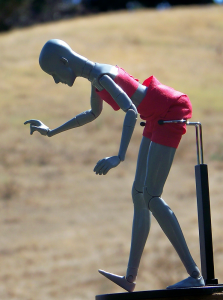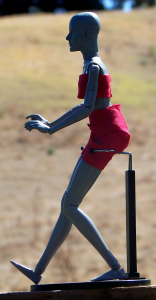When trying to brake, if you look anything like the photo on the left, then it’s time you learned the proper posture for making your brake do what it was designed to do. Once you nail the right stance, you’ll be rewarded with better braking effectiveness and confidence. And that means a whole new world of skating destinations will open up for you!
On the left, my trusty model Staci Stance would roll right into traffic because she is:
- Not bending the left knee enough to get a low center of gravity
- Mistakenly trying to press the brake pad downwards
- Bending forward at the waist and looking at her feet, which results in…
- Putting nearly half her body weight in front of the stopper
In the right photo, take note of Staci’s stance as she demonstrates an effective stop. When you practice this in your favorite car-free parking lot:
- Begin the approach from an upright coast with bent knees (Tip: you should be able to hop over a parking space line in this stance).
- Shift head, shoulders and hips sideways, so your weight is directly over the non-braking support foot
- Look forward, not down, to keep head weight behind the brake and over the support skate
- Scissors the brake foot forward by straightening the braking knee; notice the triangle at Staci’s base
- Scrub the brake forward and toward center line of travel
- Stop where you want: shove the stopper further ahead by bending the left knee more (see video)
Great news! The best posture for braking is the same stance you will use to prevent unwanted speed buildup on a downhill. But because this requires good one-footed balance in a narrow scissors, it is a skill that demands repeated practice before it begins to feel natural. That’s why you need to make dozens of stops in a car-free parking lot before getting out on the trails and streets. (I tell my students to shoot for at least 100 practice stops on a line.) For more detailed instructions, see the How to Stop section of my Orbit archives.
Once you master the proper braking stance, you will be able to relax and allow the brake to do its job, rather than trying to force it.

